Disponibile in Available in Verfügbar in





 Palazzo Ridolfi - DaLisca
Palazzo Ridolfi - DaLisca
Datato 1545, viene tradizionalmente attribuito a Bernardino Brugnoli, (1538–1585), architetto, ingegnere, cartografo ed idraulico veronese, nipote dell’architetto Michele Sammicheli, la cui impronta rimane nelle opere del nipote e del quale, Bernardino, prosegue alcune opere rimaste incompiute (Chiesa di Madonna di Campagna, cupola e campanile di San Giorgio in Braida , campanile del Duomo).

Il palazzo venne in seguito modificato con la costruzione del secondo piano, voluta dai Da Lisca, e con l’ampliamento, nel XIX sec., dell’ala, dove sono attualmente collocate le palestre, che forse ricoprì il giardino.
Nella primavera del 1797 nel palazzo si riunì il Consiglio di guerra francese che condannò alla fucilazione a Porta Nuova, i martiri delle Pasque Veronesi.
Distrutto da razzi incendiari nella notte del 23 febbraio 1945 (II guerra mondiale), si salvò il salone centrale affrescato da Domenico Riccio detto il Brusasorzi (Verona 1514? – 1567).
Attualmente il palazzo appartiene alla Provincia di Verona, che nel 1952 ricostruì l’edificio e v’insediò il Liceo Scientifico Statale “Angelo Messedaglia”, ora Liceo Statale "Carlo Montanari".
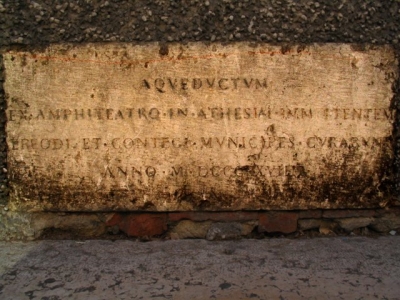
A livello del marciapiedi di Stradone Maffei, è murata una lapide in latino del 1819 che segna la scoperta del canale di scolo delle acque piovane costruito dai Romani tra l’Arena e l’Adige.
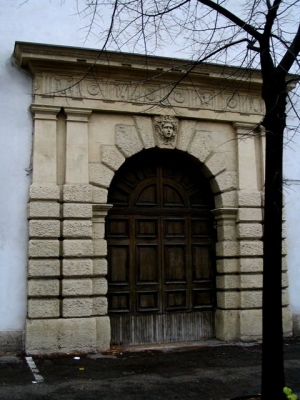
Il portale centrale, con lo stemma Da Lisca, scolpito dopo il 1890, è inquadrato da due colonne che sostengono un timpano insolitamente spezzato, per l’inserzione del bassorilievo "Il ratto d‘Europa", sormontato da un cartiglio con iscrizione in caratteri greci.
All'interno del palazzo si trova lo splendido salone - adibito ad Aula Magna del Liceo - affrescato dal già citato Domenico Brusasorzi, (1565c), alla cui bottega apprese l’arte anche Paolo Veronese. Già allievo di Giovan Francesco e Giovanni Caroto, Domenico andò anche a Venezia per apprendere l’arte da Giorgione e da Tiziano, non trascurando Raffaello.
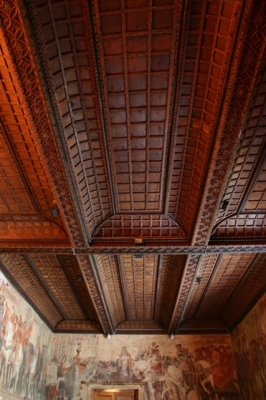
Nel 1950, nell'ambito del ripristino post-bellico, il salone, il cui soffitto era stato distrutto, fu ricoperto da due soffitti carenati in legno del tardo Quattrocento, prelevati da casa Scopoli, in vicolo B.go Tascherio.
Il salone è decorato da un fregio pittorico di 40 metri: su tre lati si sviluppa la "Cavalcata di Carlo V e di Clemente VII", mentre nella parete di fondo, interrotta da un solenne camino, si dispongono scene di genere.
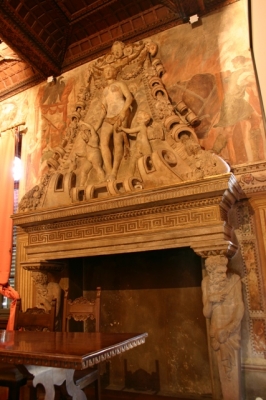
La celebre "Cavalcata" si svolse in Bologna il 24 febbraio 1530 in occasione dell'incoronazione di Carlo V ad imperatore e re d'Italia da parte di Clemente VII, che consentì il ritorno, anche se effimero, della pace in Italia e in Europa dopo la guerra della Lega Santa o di Cognac tra Carlo V e la Francia. Il tema del fregio non è nuovo ma l’affresco del Brusasorzi fu lodato, anche da Giorgio Vasari.
A Verona riscosse un gran successo e fu largamente imitato nel tardo Cinquecento, poiché il Brusasorzi compì una scrupolosa preparazione documentaria per rappresentare l’evento con verosimiglianza, che si nota soprattutto nel fasto e nella ricchezza dei particolari. Sul lato corto, tra le finestre, è presente un gran camino con la cappa decorata a stucchi. Tra volute e cartigli compare una Venere affiancata da due Amorini attribuita a Bartolomeo Ridolfi, decoratore e stuccatore di fama, che collaborò con Paolo Veronese e Andrea Palladio.
Leonardo Ricci e Giuseppe Gerola, in una ricerca storica edita in Trento, dalla Società Tipografica Trentina nel 1901, descrivono così i fatti storici immortalati nell'affresco.
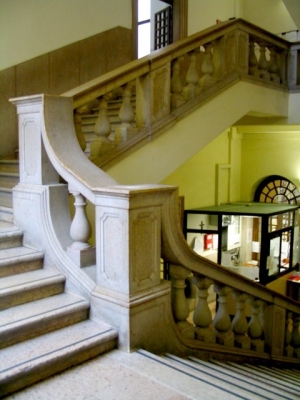
 Palazzo Ridolfi - DaLisca
Palazzo Ridolfi - DaLisca
Dated 1545, is traditionally attributed to Bernardino Brugnoli, palace ridolfi_4 (1538-1585), architect, engineer, cartographer and hydraulic Veronese, grandson of the architect Michele Sanmicheli, whose improntpalazzo ridolfi_5a remains in the works and grandson who, Bernardino continues some works left unfinished (Church of Our Lady of Country, dome and bell tower of San Giorgio in Braida, bell tower of the Cathedral).
The palace was later modified with the construction of the second floor, built by the Da Lisca, and with the expansion in the nineteenth century., Wing, where they are currently located gyms, perhaps covered the garden.
In the spring of 1797 in the palace he met the French Council of War that condemned building ridolfi_6alla shooting at Porta Nuova, the martyrs of the Veronese Easters.
Destroyed by incendiary flares on the night of February 23, 1945 (World War II), he saved the central hall frescoed by Domenico Riccio said Brusasorzi (Verona 1514? - 1567).
Currently the building belongs to the Province of Verona, who in 1952 rebuilt the building and v'insediò the Scientific High School "Angelo Messedaglia", now High School "Carlo Montanari".
At the level of the sidewalk Stradone Maffei, is a plaque in Latin in 1819, which marks the discovery of the drainage channel rainwater built by the Romans between the Arena and the Adige.
The central portal, with the crest From Lisca, carved after 1890, is framed by two columns supporting a pediment unusually broken, for insertion of the bas-relief "The Rape of Europe", surmounted by a cartouche with an inscription in Greek characters .
Inside the palace is the splendid hall - used as a Hall of Liceo - painted by the said Domenico Brusasorzi, (1565c), in whose workshop he learned the art also Paolo Veronese. Former pupil of Giovan Francesco and Giovanni Caroto, Domenico also went to Venice to learn the art of Giorgione and Titian, Raphael not neglecting.
In 1950, as part of the post-war recovery, the lounge, the ceiling of which was destroyed, was covered with two reels wooden ceilings of the late fifteenth century, taken from home Scopoli, in B.go Tascherio alley.
The living room is decorated with a frieze of paintings by 40 meters, on three sides develops the "Ride of Charles V and Clement VII", while the back wall, interrupted by a solemn fireplace, you have genre scenes.
The famous "Ride" was held in Bologna February 24, 1530 for the coronation of Charles V as Emperor and King of Italy by Pope Clement VII, which allowed the return, even if ephemeral, peace in Italy and Europe after the war of the Holy League of Cognac or between Charles V and France.
The theme of the frieze is not new but the fresco of Brusasorzi was praised, even by Giorgio Vasari.
In Verona, it was a great success and was widely imitated in the late sixteenth century, as the Brusasorzi performed a thorough preparation of documents to represent the event with verisimilitude, which is especially noticeable in the pomp and richness of detail. On the short side, between the windows, there is a large fireplace with a hood decorated with stucco. Among swirls and scrolls Venus appears flanked by two Cupids attributed to Bartolomeo Ridolfi, plasterer and decorator of fame, who collaborated with Paolo Veronese and Andrea Palladio.
Leonardo Ricci and Giuseppe Gerola, in historical research published in Trento, Trentino Tipografica by the Company in 1901, so describe historical facts immortalized in the fresco. (Translated by Google Translator)
 Palazzo Ridolfi - DaLisca
Palazzo Ridolfi - DaLisca
Datiert 1545, ist traditionell Bernardino Brugnoli, Palast ridolfi_4 (1538-1585), Architekt, Ingenieur, Kartograph und Hydraulik Veronese, der Enkel des Architekten Michele Sanmicheli, dessen improntpalazzo ridolfi_5a bleibt in den Werken und Enkel, die zugeschrieben wird, weiterhin Bernardino Einige Werke unvollendet (Church of Our Lady of Country, Kuppel und Glockenturm von San Giorgio in Braida, Glockenturm der Kathedrale).
Der Palast wurde später mit dem Bau der zweiten Etage, von der Da Lisca gebaut modifiziert und mit dem Ausbau im neunzehnten Jahrhundert., Flügel, wo sie sich gerade befinden Turnhallen, vielleicht überzogen auf den Garten.
Im Frühjahr 1797 in den Palast der Französisch Rat des Krieges, die Gebäude ridolfi_6alla Schießen auf Porta Nuova verurteilt, die Märtyrer des Veroneser Ostern traf er.
Durch Brandfackeln in der Nacht des 23. Februar 1945 (Zweiter Weltkrieg) zerstört, rettete er die zentrale Halle mit Fresken von Domenico Riccio sagte Brusasorzi (Verona 1514 - 1567).
Derzeit ist das Gebäude gehört zur Provinz Verona, die im Jahr 1952 baute das Gebäude und die v'insediò Scientific High School "Angelo Messedaglia".
Auf der Ebene der Bürgersteig Stradone Maffei ist eine Gedenktafel in Latein im Jahre 1819, der die Entdeckung der Entwässerungsrinne Regenwasser von den Römern zwischen der Arena und der Etsch erbaute markiert.
Das zentrale Portal, mit dem Wappen von Lisca, nach 1890 geschnitzt, wird von zwei Säulen, die eine ungewöhnlich Giebel gebrochen, zum Einsetzen des Flachrelief "Der Raub der Europa", die von einer Kartusche überragt mit einer Inschrift in griechischen Buchstaben gerahmten .
Im Inneren des Palastes ist die herrliche Halle - als Hall of Liceo verwendet - durch die so Domenico Brusasorzi, (1565c) gemalt, in dessen Werkstatt er lernte die Kunst auch Paolo Veronese. Ehemaliger Schüler von Giovan Francesco und Giovanni Caroto ging auch Domenico nach Venedig, zu lernen die Kunst des Giorgione und Tizian, Raphael nicht zu vernachlässigen.
Im Jahr 1950 als Teil der Wiederaufbau nach dem Krieg, in der Lounge, die Decke, die zerstört wurde, wurde mit zwei Rollen Holzdecken aus dem späten fünfzehnten Jahrhunderts, von zu Hause aus Scopoli genommen, in B.go Tascherio Bahn bedeckt.
Das Wohnzimmer ist mit einem Fries von Gemälden von 40 Metern eingerichtet, auf drei Seiten entwickelt die "Ride von Karl V. und Clemens VII", während die Rückwand, durch eine feierliche Kamin unterbrochen, Genreszenen haben Sie.
Das berühmte "Ride" wurde in Bologna 24. Februar 1530 für die Krönung von Karl V. als Kaiser und König von Italien von Papst Clemens VII, die die Rückkehr erlaubt, auch wenn ephemer, Frieden in Italien und Europa statt nach dem Krieg der Heiligen Liga von Cognac oder zwischen Karl V. und Frankreich.
Das Thema des Frieses ist nicht neu, aber das Fresko von Brusasorzi gelobt wurde, auch von Giorgio Vasari.
In Verona, war es ein großer Erfolg und wurde weit in den späten sechzehnten Jahrhundert nachgeahmt, wie der Brusasorzi führten eine gründliche Vorbereitung der Dokumente, um das Ereignis mit Wahrscheinlichkeit, die vor allem in der Pomp und Detailreichtum bemerkbar zu vertreten. Auf der kurzen Seite, zwischen den Fenstern gibt es einen großen Kamin mit einer Kapuze mit Stuck verziert. Unter wirbelt und blättert Venus scheint von zwei Amoretten zu Bartolomeo Ridolfi, Gipser und Dekorateur des Ruhmes, der mit Paolo Veronese und Andrea Palladio arbeitete zurückzuführen flankiert.
Leonardo Ricci und Giuseppe Gerola, in der historischen Forschung in Trento, Trentino Tipografica von der Gesellschaft im Jahre 1901 veröffentlicht, so beschreiben historische Fakten in dem Fresko verewigt. (Übersetzt von Google Translator).
FTF giovanni.saia 02.06.2015